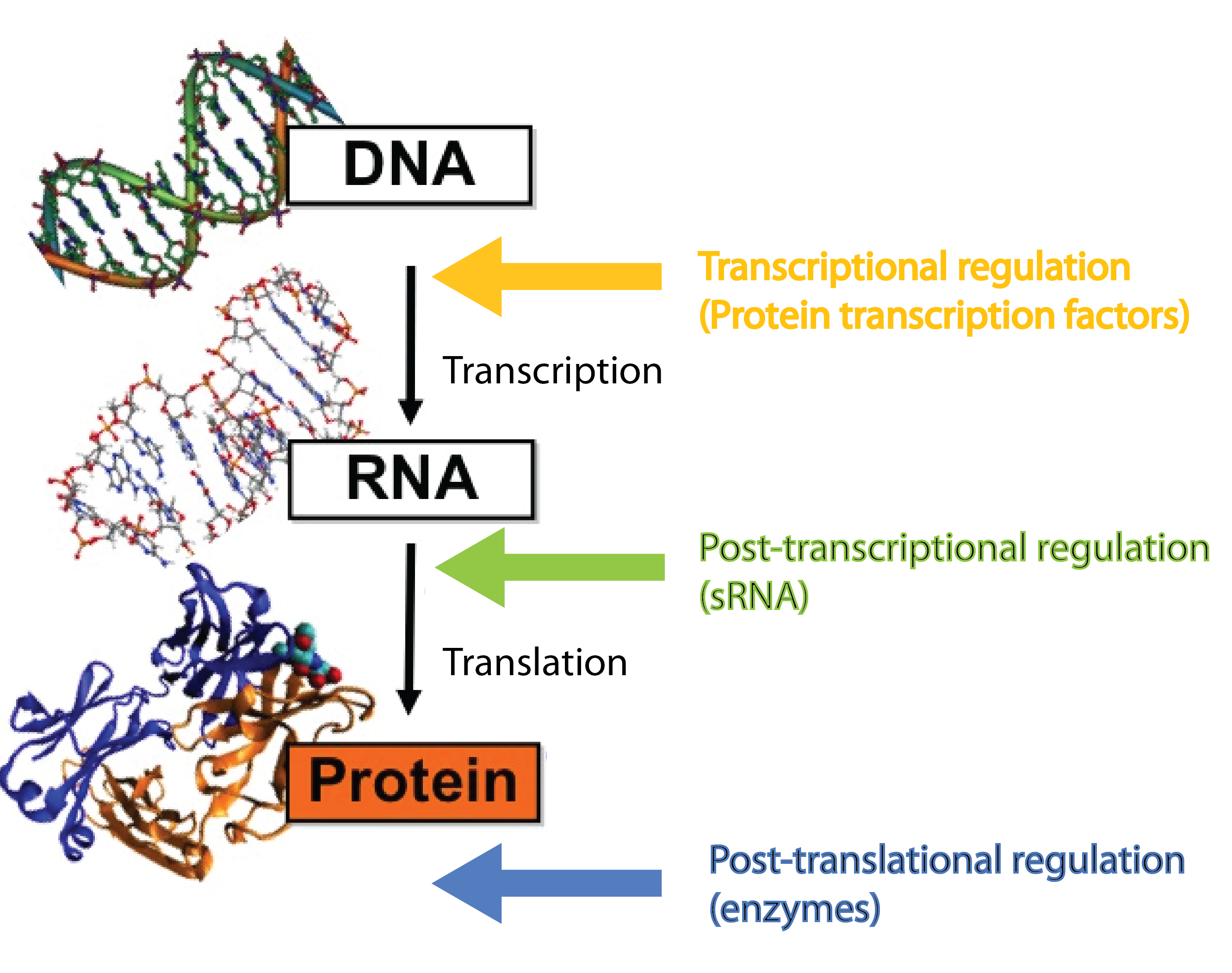Team:DTU-Denmark/What is What is sRNA
From 2011.igem.org
(Created page with "{{:Team:DTU-Denmark/Templates/Standard_page_begin|What is ...?}} ==What is sRNA== [[File:DTU1_Central_dogma_with_regulators.png|370px|thumb|left|The '''central dogma''' in biolo...") |
|||
| Line 1: | Line 1: | ||
| - | {{:Team:DTU-Denmark/Templates/Standard_page_begin|What is | + | {{:Team:DTU-Denmark/Templates/Standard_page_begin|What is: sRNA}} |
==What is sRNA== | ==What is sRNA== | ||
[[File:DTU1_Central_dogma_with_regulators.png|370px|thumb|left|The '''central dogma''' in biology, where the different levels of regulation and the players involved are highlighted. Modified from http://polaris.icmb.utexas.edu/people/cvogel/research.html]] | [[File:DTU1_Central_dogma_with_regulators.png|370px|thumb|left|The '''central dogma''' in biology, where the different levels of regulation and the players involved are highlighted. Modified from http://polaris.icmb.utexas.edu/people/cvogel/research.html]] | ||
| - | Many different kinds of RNA molecules are present in the cell; some of these are never translated into proteins. This group is collectively called non-coding RNAs, and includes, in addition to small RNA (sRNA), also rRNA and tRNA as well as more exotic RNA classes. Bacterial sRNAs are small RNA molecules (normally 50-200 nucleotides) which are extremely interesting as they have been demonstrated to play central regulatory roles in prokaryotes, where they regulate gene expression at the post-transcriptional level<span class="superscript">[[#References|[ | + | Many different kinds of RNA molecules are present in the cell; some of these are never translated into proteins. This group is collectively called non-coding RNAs, and includes, in addition to small RNA (sRNA), also rRNA and tRNA as well as more exotic RNA classes. Bacterial sRNAs are small RNA molecules (normally 50-200 nucleotides) which are extremely interesting as they have been demonstrated to play central regulatory roles in prokaryotes, where they regulate gene expression at the post-transcriptional level<span class="superscript">[[#References|[1]]]</span><span class="superscript">[[#References|[2]]]</span>. Regulatory RNAs are not restricted to prokaryotes. Eukaryotes (including mammals) use micro RNA (miRNA) in post-transcriptional regulation, which is a functional analog to sRNA<span class="superscript">[[#References|[3]]]</span>. |
| - | sRNAs act at the post-transcriptional level, a level complementary to the level at which protein regulators operate. Protein transcription factors operate before sRNAs at the transcriptional level whereas enzymes such as kinases and phosphatases act after sRNAs at the post-translational level<span class="superscript">[[#References|[ | + | sRNAs act at the post-transcriptional level, a level complementary to the level at which protein regulators operate. Protein transcription factors operate before sRNAs at the transcriptional level whereas enzymes such as kinases and phosphatases act after sRNAs at the post-translational level<span class="superscript">[[#References|[3]]]</span>. Combining different layers of regulation enables interesting regulatory outcomes, eg. '''increase the number of genes regulated in response to a given signal''' or '''extremely tight repression of genes''' - sRNA can silence leaky promoters<span class="superscript">[[#References|[3]]]</span>. Transcription factors typically bind the target gene within ~100 nucleotides of the -10 and -35 region which set an upper limit for the number of transcription factors that can regulate a given gene. By targeting a complete different part of the gene, sRNAs can '''increase the number of signals a given gene can sense'''. |
<html></div><div class="whitebox article"></html> | <html></div><div class="whitebox article"></html> | ||
==References== | ==References== | ||
| - | [1] | + | [1] Beisel, Chase L., and Gisela Storz. “Base pairing small RNAs and their roles in global regulatory networks.” FEMS Microbiology Reviews 34, no. 5 (2010): 866-882. |
| - | [2] | + | [2] Levine, Erel, Zhongge Zhang, Thomas Kuhlman, and Terence Hwa. “Quantitative characteristics of gene regulation by small RNA.” PLoS biology. 5, no. 9 (2007). |
| - | [3 | + | [3] Waters, Lauren S., and Gisela Storz. “Regulatory RNAs in Bacteria.” Cell 136, no. 4 (2009): 615-628. |
| - | + | ||
| - | + | ||
| - | + | ||
| - | + | ||
| - | + | ||
| - | + | ||
| - | + | ||
| - | + | ||
{{:Team:DTU-Denmark/Templates/Standard_page_end}} | {{:Team:DTU-Denmark/Templates/Standard_page_end}} | ||
Revision as of 10:20, 21 September 2011
What is: sRNA
What is sRNA
Many different kinds of RNA molecules are present in the cell; some of these are never translated into proteins. This group is collectively called non-coding RNAs, and includes, in addition to small RNA (sRNA), also rRNA and tRNA as well as more exotic RNA classes. Bacterial sRNAs are small RNA molecules (normally 50-200 nucleotides) which are extremely interesting as they have been demonstrated to play central regulatory roles in prokaryotes, where they regulate gene expression at the post-transcriptional level[1][2]. Regulatory RNAs are not restricted to prokaryotes. Eukaryotes (including mammals) use micro RNA (miRNA) in post-transcriptional regulation, which is a functional analog to sRNA[3].
sRNAs act at the post-transcriptional level, a level complementary to the level at which protein regulators operate. Protein transcription factors operate before sRNAs at the transcriptional level whereas enzymes such as kinases and phosphatases act after sRNAs at the post-translational level[3]. Combining different layers of regulation enables interesting regulatory outcomes, eg. increase the number of genes regulated in response to a given signal or extremely tight repression of genes - sRNA can silence leaky promoters[3]. Transcription factors typically bind the target gene within ~100 nucleotides of the -10 and -35 region which set an upper limit for the number of transcription factors that can regulate a given gene. By targeting a complete different part of the gene, sRNAs can increase the number of signals a given gene can sense.
References
[1] Beisel, Chase L., and Gisela Storz. “Base pairing small RNAs and their roles in global regulatory networks.” FEMS Microbiology Reviews 34, no. 5 (2010): 866-882.
[2] Levine, Erel, Zhongge Zhang, Thomas Kuhlman, and Terence Hwa. “Quantitative characteristics of gene regulation by small RNA.” PLoS biology. 5, no. 9 (2007).
[3] Waters, Lauren S., and Gisela Storz. “Regulatory RNAs in Bacteria.” Cell 136, no. 4 (2009): 615-628.
 "
"









